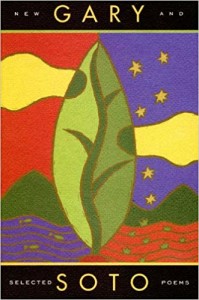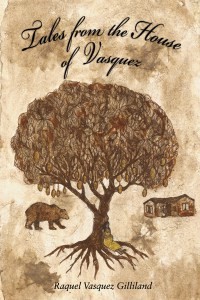I’m grateful to poet Lynn Martin for introducing me to Soto’s work. Born in the U.S. to Mexican-American parents, Soto grew up hard after his father died when he was only five. Many of the poems in this collection speak of that life, work in the fields and factories, encounters on the street.
He tells stories of collecting copper and dancing in Kearney Park. He tells of his grandma who “Pounded chiles / With a stone / Brought from Guadalajara” burying a cigar box of money. He tells of a couple getting ready to leave a cantina and a widow “slumped down in the closet / Among a pile of dirty clothes”.
Many of the poems are like paintings, landscapes—urban and wild—that he conjures for us so clearly. The first poem, the title poem of his first collection, “The Elements of San Joaquin” is a perfect example. In sections with titles like field, wind, sun, fog, he seduces us with images:
A dry wind over the valley
Peeled mountains, grain by grain,
To small slopes, loose dirt
Where red ants tunnel.The wind strokes
The skulls and spines of cattle
To white dust, to nothing,Covers the spiked tracks of beetles,
Of tumbleweed, of sparrows
That pecked the ground for insects.
Yet, the way he shows us the reality of a migrant worker’s life, without rancor, is persuasive. There’s no need for political slogans or outraged cries.
When autumn rains flatten sycamore leaves,
The tiny volcanos of dirt
Ants raised around their holes,
I should be out of work.. . .
The skin of my belly will tighten like a belt
And there will be no reason for pockets.
With moments of witness like these, I understand why his poems are often used in schools. I see that he is also author of 21 Young Adult and children’s books. In fact, I am astounded by his output: fifteen poetry collections, eight memoirs, a play and two films, while also editing four anthologies.
Sometimes a poem is a story; sometimes just a slice of life. One of my favorites is “Mission Tire Factory, 1969” which starts out:
All through lunch Peter pinched at his crotch,
And Jesús talked about his tattoos,
And I let the flies crawl my arm, undisturbed,
Thinking it was wrong, a buck sixty five,
The wash of rubber in our lungs,
The oven we would enter, squinting . . .
It then delves into an incident both tragic and funny, as well as sweet. I particularly appreciate this aspect of Soto’s work because I know how harmful and hurtful stereotypes can be, whether we’re talking about welfare mothers like me or immigrants or people of color or those with mental or physical handicaps. By taking us into the lives of Latinx workers, parents, and children, Soto gives us reason to respect them and—even more—see ourselves in them.
These poems show Soto walking a sometimes uneasy path between his early life working in the fields and his current life as college professor and award-winning poet. While “The Elements of San Joaquin” gives us an inside look into the life of a seasonal fieldworker, “Ars Poetica, or Mazatlan, on a Day When Bodies Wash to the Shore” holds the mixed emotions of how far he has come (or not come) since those days.
With vivid details, the narrator describes how he and Omar, presumably a friend, explored the town.
Earlier, we were at the mercado,
With its upside down chickens
Blinking blood from all holes.
Fat cats from the north, they left big tips in restaurants, happy to be able to help the poor of Mazatlan. Then he says, “Now we’re not so sure.” In even more vivid detail he describes the body of a man washed up on the beach. Again he says:
Now we’re not so sure.
. . .
The truth is, we want to go home,
Vanish in the train’s white smoke,
And miraculously find ourselves
In America.
It is death that finds us, unready, our work unfinished, and no amount of privilege will save us.
There is craft here, in the sounds and tastes, in the choice of details, in the music of the lines, but these poems are so accessible that you don’t need to know any craft to enjoy them. He welcomes us into his world and we find ourselves at home there.
Have you read Gary Soto’s poetry? Which of his poems would you recommend?

